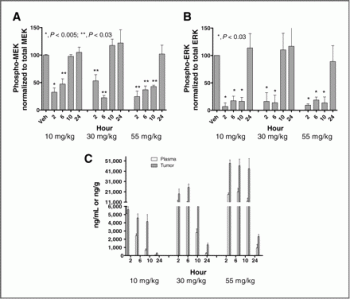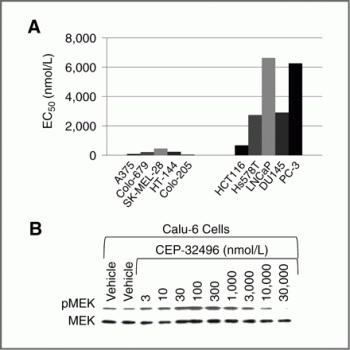
| Size | Price | Stock | Qty |
|---|---|---|---|
| 2mg |
|
||
| 5mg |
|
||
| 10mg |
|
||
| 25mg |
|
||
| 50mg |
|
||
| 100mg |
|
||
| 500mg |
|
||
| Other Sizes |
|
Purity: ≥98%
Agerafenib (formerly RXDX105; AC013773; RXDX-105; CEP-32496; AC-01377) is a potent and orally bioactive inhibitor of BRAFV600E and c-Raf with potential antitumor activity. It blocks BRAFV600E with Kd values of 14 nM, 39 nM, and so forth. Other kinases like MEK-1, MEK-2, ERK-1, and ERK-2 exhibited little to no inhibition in response to agerafenib.
| Targets |
BRaf(V600E) (Kd = 14 nM); Braf (Kd = 36 nM); CRAF (Kd = 39 nM); c-Kit (Kd = 2 nM); Ret (Kd = 2 nM); LCK (Kd = 2 nM); Abl-1 (Kd = 3 nM); VEGFR-2 (Kd = 8 nM); CSF-1R (Kd = 9 nM); EPHA2 (Kd = 14 nM); EGFR (Kd = 22 nM); c-Met (Kd = 513 nM); JAK-2 (Kd = 4700 nM); MEK-1 (Kd = 7100 nM); MEK-2 (Kd = 8300 nM)
|
|---|---|
| ln Vitro |
CEP-32496 inhibits A375 cell (BRAFV600E) proliferation with EC50 of 78 nM. For tumor cell lines expressing mutant BRAF (A375, SK-MEL-28, Colo-205, Colo-679, and HT-144) compared to those expressing wild-type BRAF (HCT116, Hs578T, LNCaP, DU145, and PC-3), CEP-32496 displays more sensitive cytotoxicity. [1] Human melanoma (A375) and colorectal cancer (Colo-205) cell lines exhibit pMEK mitogen-activated protein (MAP)/extracellular signal-regulated (ER) kinase (pMEK) phosphorylation (pMEK) inhibition by CEP-32496 with IC50 values of 78 nM and 60 nM, respectively. [2]
|
| ln Vivo |
CEP-32496 exhibits good stability in mouse, dog, monkey, and human liver microsomal preparations with measured intrinsic clearance values of <23 (μL/min)/mg and t1/2 > 60 min in all assays. In the Colo-205 xenograft mouse model, CEP-32496 (30 mg/kg, orally, BID) displays tumor stasis and a 40% incidence of partial tumor regressions (PRs), whereas the 100 mg/kg dose group displays both tumor stasis and an 80% incidence of PRs. A 55 mg/kg dose of CEP-32496 results in a 75% to 57% inhibition of pMEK at 2 hours through 10 hours after administration in a Colo-205 xenograft mouse model, whereas CEP-32496 (30 mg/kg, orally, BID) leads to a 50% and 75% inhibition of normalized pMEK in tumor lysates at the 2 hours and 6 hours postdose time points, respectively.[1] In numerous preclinical species, CEP-32496 is orally bioavailable (>95% in rats, dogs, and monkeys). Inhibition of pMEK and pERK, sustained tumor stasis, and regressions in BRAF(V600E) colon carcinoma xenografts in nude mice are the effects of CEP-32496 (100 mg/kg). [2]
|
| Enzyme Assay |
Kinases are made and then displayed on the T7 phage or expressed in HEK-293 cells and DNA-tagged. The fraction of kinase not bound to the test compound is determined by capture with an immobilized affinity ligand and quantitation by quantitative PCR after binding reactions are carried out at room temperature for an hour. The CEP-32496 test is performed on each kinase separately. Kd values are calculated from eleven serial 3-fold dilutions and are shown as the mean of two independent experiments. Individual value variation is less than two times.
|
| Cell Assay |
In DMEM containing 10% fetal calf serum, 104 cells are seeded per well, and the cells are then allowed to attach. Following a PBS wash, the cells are switched to DMEM containing 0.5% serum and incubated for an overnight period. Then, CEP-32496 is added at varying concentrations with a 0.5% final DMSO concentration, and the mixture is incubated for 72 hours. After three hours of incubation, Cell Titer Blue is added as directed and the process is repeated. Using SoftMax Pro (excitation at 560 nm and emission at 590 nm), the number of remaining viable cells is determined by calculating the intensity of the fluorescence signal. In order to calculate the IC50 values, a 9-point curve was fitted with Igor Pro. The results are shown as the mean values of duplicate experiments. Less than a 2-fold difference exists between individual values.
|
| Animal Protocol |
Mice: Approximately 1×106 Colo-205 tumor cells are subcutaneously injected into the right flank of six to eight week-old athymic nu/nu nude mice (20-25 g). Animals are randomly assigned to treatment groups (n=10 mice/group) once their tumors have grown to an average size of 150–200 mm3 (10–12 days after implantation). Agerafenib is administered orally to each group for 14 days in doses of 10, 30, or 100 mg/kg twice daily (BID), adjusted for the animal's body weight, in volumes of 0.1 mL per 20 g of body weight. The vehicle alone (22% HPβCD) is also given to each group. Vernier calipers are used to measure tumor volume three times per week, and volume is calculated.
|
| References | |
| Additional Infomation |
Agerafenib is under investigation in clinical trial NCT03052569 (Expanded Access to RXDX-105 for Cancers With RET Alterations).
Agerafenib is an orally available v-raf murine sarcoma viral oncogene homolog B1 (B-raf) serine/threonine protein kinase inhibitor with potential antineoplastic activity. Agerafenib specifically and selectively inhibits the activity of the mutated form (V600E) of B-raf kinase. This inhibits the activation of the RAF/mitogen-activated protein kinase kinase (MEK)/extracellular signal-related kinase (ERK) signaling pathway and may result in a decrease in the proliferation of tumor cells expressing the mutated B-raf gene. The Raf mutation BRAF V600E, in which valine is substituted for glutamic acid at residue 600, is frequently found in a variety of human tumors and results in the constitutive activation of the RAF/MEK/ERK signaling pathway that regulates cellular proliferation and survival. |
| Molecular Formula |
C24H22F3N5O5
|
|
|---|---|---|
| Molecular Weight |
517.46
|
|
| Exact Mass |
517.157
|
|
| Elemental Analysis |
C, 55.71; H, 4.29; F, 11.01; N, 13.53; O, 15.46
|
|
| CAS # |
1188910-76-0
|
|
| Related CAS # |
Agerafenib hydrochloride;1227678-26-3
|
|
| PubChem CID |
56846693
|
|
| Appearance |
White to off-white solid powder
|
|
| LogP |
5.346
|
|
| Hydrogen Bond Donor Count |
2
|
|
| Hydrogen Bond Acceptor Count |
11
|
|
| Rotatable Bond Count |
7
|
|
| Heavy Atom Count |
37
|
|
| Complexity |
776
|
|
| Defined Atom Stereocenter Count |
0
|
|
| SMILES |
FC(C(C([H])([H])[H])(C([H])([H])[H])C1=C([H])C(N([H])C(N([H])C2C([H])=C([H])C([H])=C(C=2[H])OC2C3=C([H])C(=C(C([H])=C3N=C([H])N=2)OC([H])([H])[H])OC([H])([H])[H])=O)=NO1)(F)F
|
|
| InChi Key |
DKNUPRMJNUQNHR-UHFFFAOYSA-N
|
|
| InChi Code |
InChI=1S/C24H22F3N5O5/c1-23(2,24(25,26)27)19-11-20(32-37-19)31-22(33)30-13-6-5-7-14(8-13)36-21-15-9-17(34-3)18(35-4)10-16(15)28-12-29-21/h5-12H,1-4H3,(H2,30,31,32,33)
|
|
| Chemical Name |
1-[3-(6,7-dimethoxyquinazolin-4-yl)oxyphenyl]-3-[5-(1,1,1-trifluoro-2-methylpropan-2-yl)-1,2-oxazol-3-yl]urea
|
|
| Synonyms |
|
|
| HS Tariff Code |
2934.99.9001
|
|
| Storage |
Powder -20°C 3 years 4°C 2 years In solvent -80°C 6 months -20°C 1 month |
|
| Shipping Condition |
Room temperature (This product is stable at ambient temperature for a few days during ordinary shipping and time spent in Customs)
|
| Solubility (In Vitro) |
|
|||
|---|---|---|---|---|
| Solubility (In Vivo) |
Solubility in Formulation 1: ≥ 2.5 mg/mL (4.83 mM) (saturation unknown) in 10% DMSO + 40% PEG300 + 5% Tween80 + 45% Saline (add these co-solvents sequentially from left to right, and one by one), clear solution.
For example, if 1 mL of working solution is to be prepared, you can add 100 μL of 25.0 mg/mL clear DMSO stock solution to 400 μL PEG300 and mix evenly; then add 50 μL Tween-80 to the above solution and mix evenly; then add 450 μL normal saline to adjust the volume to 1 mL. Preparation of saline: Dissolve 0.9 g of sodium chloride in 100 mL ddH₂ O to obtain a clear solution. Solubility in Formulation 2: ≥ 2.5 mg/mL (4.83 mM) (saturation unknown) in 10% DMSO + 90% (20% SBE-β-CD in Saline) (add these co-solvents sequentially from left to right, and one by one), clear solution. For example, if 1 mL of working solution is to be prepared, you can add 100 μL of 25.0 mg/mL clear DMSO stock solution to 900 μL of 20% SBE-β-CD physiological saline solution and mix evenly. Preparation of 20% SBE-β-CD in Saline (4°C,1 week): Dissolve 2 g SBE-β-CD in 10 mL saline to obtain a clear solution. View More
Solubility in Formulation 3: ≥ 2.5 mg/mL (4.83 mM) (saturation unknown) in 10% DMSO + 90% Corn Oil (add these co-solvents sequentially from left to right, and one by one), clear solution. Solubility in Formulation 4: 15% Captisol: 15mg/mL |
| Preparing Stock Solutions | 1 mg | 5 mg | 10 mg | |
| 1 mM | 1.9325 mL | 9.6626 mL | 19.3252 mL | |
| 5 mM | 0.3865 mL | 1.9325 mL | 3.8650 mL | |
| 10 mM | 0.1933 mL | 0.9663 mL | 1.9325 mL |
*Note: Please select an appropriate solvent for the preparation of stock solution based on your experiment needs. For most products, DMSO can be used for preparing stock solutions (e.g. 5 mM, 10 mM, or 20 mM concentration); some products with high aqueous solubility may be dissolved in water directly. Solubility information is available at the above Solubility Data section. Once the stock solution is prepared, aliquot it to routine usage volumes and store at -20°C or -80°C. Avoid repeated freeze and thaw cycles.
Calculation results
Working concentration: mg/mL;
Method for preparing DMSO stock solution: mg drug pre-dissolved in μL DMSO (stock solution concentration mg/mL). Please contact us first if the concentration exceeds the DMSO solubility of the batch of drug.
Method for preparing in vivo formulation::Take μL DMSO stock solution, next add μL PEG300, mix and clarify, next addμL Tween 80, mix and clarify, next add μL ddH2O,mix and clarify.
(1) Please be sure that the solution is clear before the addition of next solvent. Dissolution methods like vortex, ultrasound or warming and heat may be used to aid dissolving.
(2) Be sure to add the solvent(s) in order.
|
 |
 |